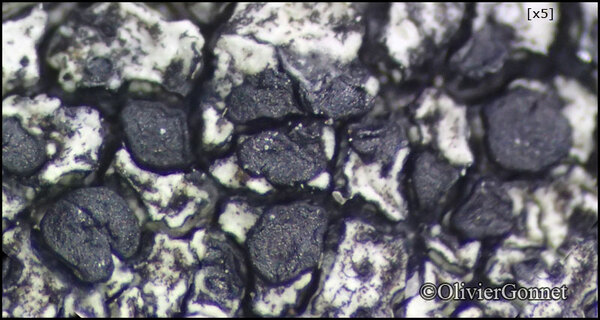Carbonea distans (Kremp.) Hafellner & Obermayer
in Obermayer, Mitt. naturwiss. Ver. Steiermark, 123: 116, 1993. Basionym: Lecidea distans Kremp. - Flora, 37: 71, 1855.
Synonyms: Biatora mosigiicola Eitner; Lecanora mosigiicola (Eitner) Hertel & Rambold; Lecidea straminea Anzi
Distribution: N - Frl (Tretiach & Hafellner 2000), TAA (Hertel & Schuhwerk 2010, Hafellner 2021, Nascimbene & al. 2022), Lomb, Piem (TSB 35201).
Description: Thallus crustose, thinly episubstratic, greenish white to yellowish white, of 0.3-1 mm wide, smooth, flattened, contiguous areoles developing on a black hypothallus, growing on the thalli of Orphniospora mosigii. Medulla white, I-. Apothecia lecideine to biatorine, black, 0.3-0.8 mm across, semi-immersed to adnate, apparently arising between the areoles, with a flat to slightly convex, epruinose disc, and a very thin, soon excluded proper margin. Proper exciple thin, greenish black in outer part, paler within; epithecium blue-green, N+ purple-red; hymenium colourless or greenish in upper part, 50-70 µm high; paraphyses conglutinated, simple, 1.5-2 µm thick at mid-level, the apical cell to c. 2 µm wide; hypothecium colourless to pale brown. Asci 8-spored, clavate, the K/I+ blue tholus penetrated by a faintly amyloid apical cushion with parallel or diverging flanks, the outer wall very thin, K/I-, surrounded by a K/I+ blue outer layer, Lecanora-type. Ascospores 1-celled, hyaline, ellipsoid, 8-15 x 3-6.5 µm. Conidia thread-like, 15-30 µm long. Photobiont chlorococcoid. Spot tests: all negative or thallus K+ and KC+ faintly yellowish. Chemistry: thallus with variable amounts of usnic acid.Note: an arctic-alpine obligate parasite on the thalli of Orphniospora mosigii, found on steeply inclined, exposed faces of hard siliceous rocks near or above treeline; the species is certainly more widespread in the Alps.
Growth form: Crustose
Substrata: rocks
Photobiont: green algae other than Trentepohlia
Reproductive strategy: mainly sexual
paras Orphniospora mosigii
Commonnes-rarity: (info)
Alpine belt: rather rare
Subalpine belt: rare
Oromediterranean belt: absent
Montane belt: absent
Submediterranean belt: absent
Padanian area: absent
Humid submediterranean belt: absent
Humid mediterranean belt: absent
Dry mediterranean belt: absent

Predictive model
Herbarium samples


P.L. Nimis; Owner: Department of Life Sciences, University of Trieste
Herbarium: TSB (26479)
2001/11/25

Courtesy: Olivier et Danièle Gonnet - Source: https://www.afl-lichenologie.fr/Photos_AFL/Photos_AFL_C/Textes_C5/Carbonea_distans.htm
France, Job - Puy-de-Dôme
20/8/2013
Growth form: Crustose
Substrata: rocks
Photobiont: green algae other than Trentepohlia
Reproductive strategy: mainly sexual
paras Orphniospora mosigii
Commonnes-rarity: (info)
Alpine belt: rather rare
Subalpine belt: rare
Oromediterranean belt: absent
Montane belt: absent
Submediterranean belt: absent
Padanian area: absent
Humid submediterranean belt: absent
Humid mediterranean belt: absent
Dry mediterranean belt: absent

Predictive model
| Herbarium samples |


P.L. Nimis; Owner: Department of Life Sciences, University of Trieste
Herbarium: TSB (26479)
2001/11/25

 Index Fungorum
Index Fungorum
 GBIF
GBIF














